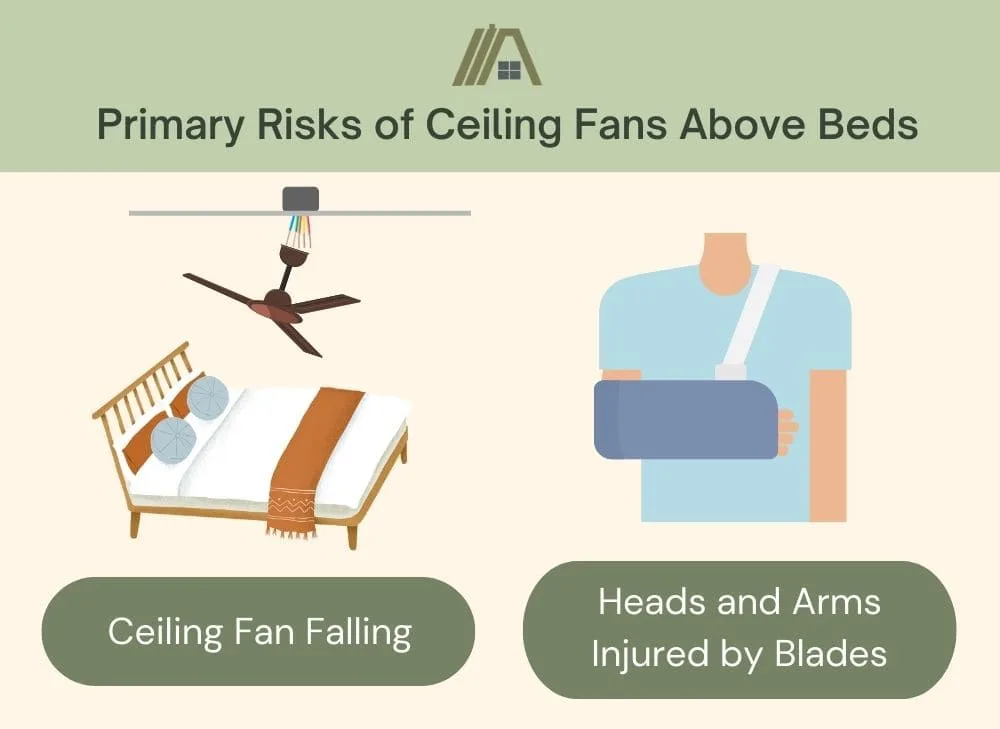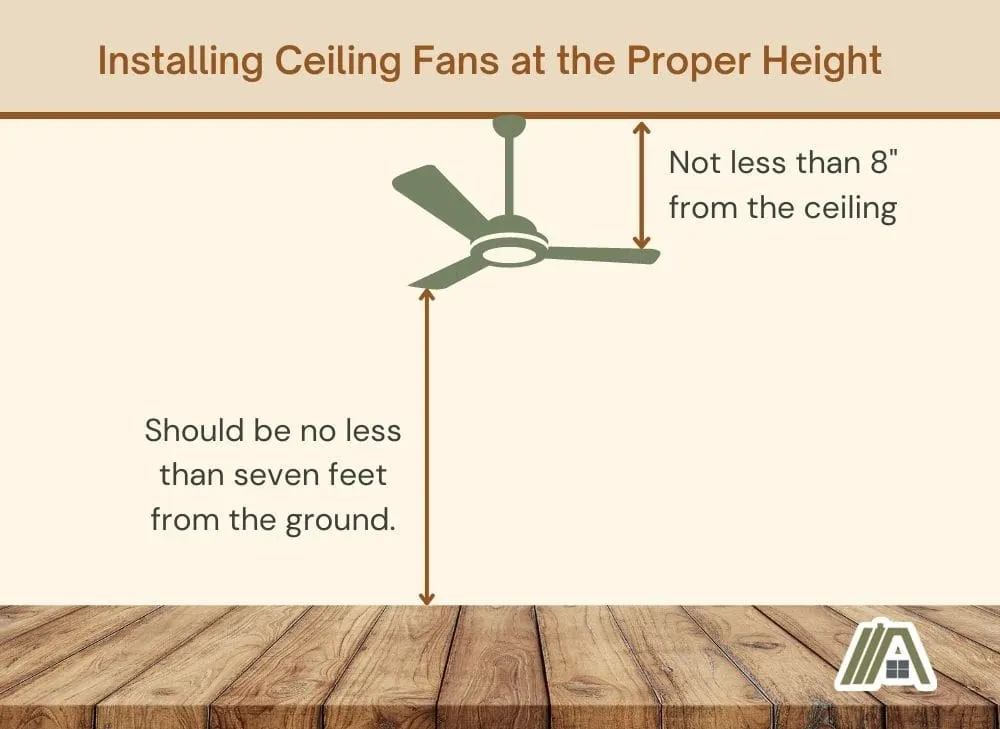Where I live, the weather can be super hot in summer. I currently counter the heat with a pedestal fan, but my dream is to install a ceiling fan above my bed because it’s way better looking and doesn’t take up floor space. But it’s no good dreaming of the pros without first considering the cons. One con, in particular, is the safety risk associated with this installation.
There is definitely a risk of injury if you install a ceiling fan above the bed. This is a simple fact. But don’t stop reading! In the field of health and safety, the presence of risk is not the same as the likelihood of risk, and there are many ways that you can mitigate an already low risk.

If proper precautions are taken, it’s safe to have a ceiling fan above a bed. The exceptions are bunk beds and loft beds. Ceiling fans should never be above these. Proper precautions include correct installation, proper wiring, and behavioral adaptations.
Primary Risks of Ceiling Fans Above Beds
There are two main risks to consider when installing a ceiling fan above the bed. First, people worry that the ceiling fan will fall. Second, heads and arms can hit the fan blades, causing injury. As long as care is taken to mitigate the chance of injury, you don’t have to avoid having an above-bed ceiling fan.

1. Ceiling Fan Falling
The greatest fear people have about a ceiling fan above the bed is that fans will break and fall out of their brackets or the ceiling. However, as long as the fan is properly installed, this is a very unlikely situation.
Even if it does occur, the wires can often catch the ceiling fan, preventing it from falling too far. This can damage the wiring and lead to other issues, but you won’t be hit by the falling fan. If this happens, the wiring should be repaired as soon as possible.
A falling ceiling fan can certainly cause injuries, but deaths are very rare (and are typically indirect as a result of head injury). If this is a big fear for you, positioning the fan above the foot of the bed may help ease this worry. The weight and fall-height of the fan, as well as where it hits you, would determine the severity of the injury.
Even though this is the situation that causes most worry, it’s actually less likely than the second risk.
2. Heads and Arms Injured By The Blades
More often than ceiling fans falling, people can be injured by coming into contact with ceiling fan blades.
When fans are above beds, injury is especially likely if children are jumping on the bed. In fact, any activity involving standing on the bed (such as cleaning/dusting, painting, etc.) can pose a risk to people.
If a ceiling fan is installed too low, it is also likely to cause people head or arm injuries from simply stretching beneath the working fan. Taller people are more at risk for injuries from low-hanging fans.
The impact from fan blades can cause bruising, muscle or nerve damage, lacerations, and in the worst case, a concussion or other brain injury.
Preventing Ceiling Fans From Falling
Proper installation will prevent ceiling fans from falling. If your fan is already installed, you can get a ceiling fan inspection to check that it has been properly fixed into your ceiling.
Installing a fan from scratch requires an electrical junction box and fan brace box. If you’re converting a light fixture to a ceiling fan, you’ll need to upgrade the junction box.
Using the Proper Electrical Junction Box
The electrical junction boxes used for a light fixture are different than the ones used for fans. The electrical junction box supports the fan and must be listed by the National Electric Code as safe to use for fans.
The reason special junction boxes are required is due to forces from the fan (especially rotation) that will cause the support to fail if it is only designed to hold a light.
The information on the junction box will state if it’s rated to support ceiling fans but there are also other ways to tell.

Junction Boxes Must Be Attached to Joists
Just using a fan-rated junction box is pointless if you do not attach it to the ceiling joists. These ultimately provide the support for the ceiling fan, making the actual ceiling boards non-weight-bearing.
Ceiling Fan Braces and Safety Cables/Wires
A ceiling fan brace (amazon link) supports the junction box when the fan is installed between two joists. It’s really important that the fan is not hanging from the ceiling alone because drywall is not strong enough to hold the fan.
A mounting brace wedges itself between ceiling joists to ensure that the bulk of the fan’s weight is borne by these structural supports. Check that your mounting bracket and electric box are compatible with these braces before purchase.
A video on installing a ceiling fan brace is found below:
For heavy fans, you can use a safety cable (amazon link) to hold the fan in place. They add an extra measure of security by holding the fan to the mount or joist to prevent the fan body from falling even if the support housing breaks.
Cables similar to these are also used to attach ceiling fans to joists in drop ceilings.
Mitigating the Chance of Head and Arm Injuries
To avoid head and arm injuries, the best modes of action are to get the fan as high off the ground (and away from the bed) as possible and to change your habits and the behavior of your loved ones to avoid contact with the ceiling fan.
Installing Ceiling Fans at the Proper Height
Neither the International Residential Code (IRC) nor the National Electrical Code (NEC) gives specific height recommendations for ceiling fans. However, fan manufacturers and the EPA Energystar program do provide clearance parameters. They suggest that fan blades should be no less than seven feet from the ground.
To avoid injury from contact with ceiling fan blades, try to install your ceiling fan as close to the ceiling as possible (but not less than 8″ from the ceiling or you will impair the efficiency of the fan). The distance between the fan and the bed will already be shorter than between the fan and the floor, so avoid using a long down rod, especially if you have low ceilings.

Making Behavioral Changes to Avoid Injury
If you have children, prohibit them from jumping on the bed or engaging in any activity that has them standing on the bed, if possible. When children are present in the bedroom, it may be a good idea to lower the fan speed or turn it off.
Adults should also avoid standing on the bed to clean, paint, etc. If you plan to stand on the bed for whatever reason, make sure the fan is turned off to avoid causing greater pain in case of knocking against it.
Any tall people should also take care to not reach up or walk under a low-hanging ceiling fan.
Bunk Beds/Loft Beds
There are two scenarios in which having a ceiling fan above a bed becomes far more dangerous: when the beds are bunk beds or loft beds.
Bunk or loft beds are typically much closer to the ceiling than any other type, increasing the risk of injury exponentially. Even having a ceiling fan adjacent to one of these beds is not a good idea.
Another factor that weighs in here is the fact that bunk beds and loft beds are typically used by children who generally and naturally have less developed action-consequence processing. In other words, they are more impulsive.
In all other cases, I think that having a ceiling fan above the bed (or at least in the bedroom) is a really good idea.
Sources
https://www.nachi.org/ceiling-fan-inspection.htm
https://ceilingfantips.com/can-a-ceiling-fan-fall-and-how-to-prevent-this/

